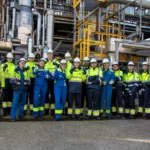
In summer 2022, Europe experienced its most severe drought in 500 years. In addition to affecting many communities across Europe, the drought and water scarcity had consequences for the manufacturing sector as well, including the chemical industry.
This is why Cefic together with France Chimie organised a dedicated workshop to discuss how the chemical industry could deal with water scarcity and raise awareness on other water related challenges for the sector.
“We see the impact of droughts directly on the chemical industry’s activities, for instance on our ability to transport”, said Cefic’s Director General Marco Mensink. In Europe, inland waterway plays an important role for the transport of goods. Marie Zimmer, Head of Responsible Care / Corporate Social Responsibility at France Chimie, added that “water has become an issue of industrial and environmental performance. We need to support companies to tackle water scarcity and further improve their water management , so the industrial sites can better defend themselves in case of crisis”.
Water scarcity is an emergency of our times, especially due to the interplay between climate change, increasing fluctuations in water availability, and the higher energy, food, digital and industrial transition needs. According to the European Environmental Agency (EEA), every year, 40% of European population is either permanently or seasonally affected by water scarcity.
“Analysing the trends over the last 20 or 10 years, these are quite worrying. When we look to the future, we also expect quite negative developments in terms of climate change impacts on water resources, since weather extremes are becoming more common”, explained Stéphane Isoard, Head of Group for Assessments and Actionable Knowledge, at EEA.
What is the legislative framework?
Water scarcity and circularity are covered by specific policies to stimulate water efficiency and reuse, such as the ‘Industrial Emissions Directive’, the ‘Eco-design for sustainable products’ regulation, and the new rules under the ‘Water Reuse Regulation’, foreseen for June 2023. Water quality, in turn, is covered in the policy context by the ‘Zero pollution action plan’, the revamped ‘Industrial Emissions Directive’, and the revised ‘Urban waste-water treatment directive’.
“To ensure security of supply, structural changes are needed now to prevent overuse, and make the European Union’s water management more resilient. Our responsibility is to establish the right framework conditions and enable all relevant public and private actors to accelerate forward. We can only get there if all Members States, European Parliament, and all stakeholders play the game”, said Veronica Manfredi, Director for Zero Pollution, Directorate-General for Environment, European Commission.
How can the industry help address water scarcity?
The EEA agrees that better water management is everybody’s job: the water sector, citizens, town planners, chemical industry, legislators, etc. It is estimated that EU industry can save up to 30% of its total water abstraction just by improving water use efficiency, according to an EEA water saving study.
Improving water management requires a systemic change, whereby companies from various sectors – but located in one area – will have to work together because water availability is almost always a regional issue.
At company level, the chemical industry has been developing and implementing water saving technologies, from reducing consumption and recycling water used during production, to lowering water pollution. The cross-sectoral approach on a local level is the next step that needs to be further enhanced.
Several national chemical associations support improved water management efforts of their members by setting up learning networks, developing guidance and sharing best practices, and mapping savings potential on a company level. Essenscia, from Belgium, for example, has launched a ‘Learning Network Water’, with more than 50 companies from the chemical and life sciences exchanging insights and reporting on the different steps to be taken to save and reuse more water.
According to a risk assessment that the World Wildlife Fund (WWF) conducted amongst over 5,000 pharmaceutical manufacturing sites, a stewardship approach is the only viable option to mitigate future water-related risks. What does that mean? Water stewardship considers how water use affects the environment, where a facility is, or how the environment affects the sites. Water stewardship is an extension of management as it takes into consideration local environmental risks and dependencies while requiring the involvement of other external stakeholders to take collective action.

The picture shows the steps that need to be taken by companies and external stakeholders in order to implement water stewardship, according to WWF.
Next steps
The workshop by Cefic and France Chimie offered the space for a first engagement of the sector on water scarcity.
“We see the need for industry to report on how it makes progress on water management”, said Ann Dierckx, Cefic Sustainability Director. “Our motivation is to inspire the sector to follow up and improve its water management performance. That’s why it is important to come together, create a learning experience and create awareness with those that are not yet there.”, stressed Dierckx. Being able to diagnose current and future risks for the chemical sector, based on WWF’s approach for the pharmaceutical sector, could represent an important step forward.










